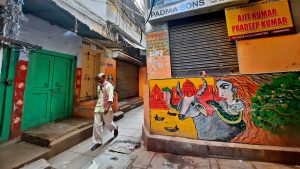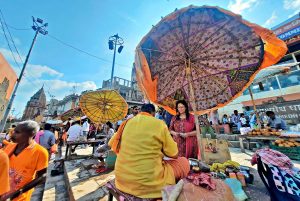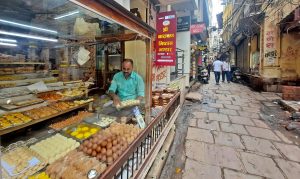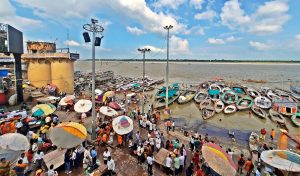Varanasi, said to be one of the oldest continuously lived cities in the world, still hides many surprises in its fold. Uttara Gangopadhyay stumbles upon a palatial building which ties Serampore with Varanasi.
The noise and traffic of Varanasi fell back as our car entered the green-edged driveway and pulled up beneath the porch of a stately double storied mansion. The porch, we later learned, once upon a time, had seen royalties and eminent personalities descend from grand horse carriages.
But that hot August afternoon, after a morning flight from Kolkata and an hour’s drive from the Lal Bahadur Shastri International Airport, it was the ice-cold watermelon juice proffered by the staff that was all that we had eyes for.
A short wide flight of stairs led us to a wide veranda with rooms opening on all three sides. A staircase with an old fashioned wrought iron railing went up to the first floor. We flopped down on the chairs strewn on the veranda as Sheroo-ji, who represented our host Kunal Dalmia, bustled about like a mother hen, plying us with home-made snacks, ensuring our luggage was put in the rooms, and the air conditioners were running to full.
A staircase with an old fashioned wrought iron railing went up to the first floor. We flopped down on the chairs strewn on the veranda as Sheroo-ji, who represented our host Kunal Dalmia, bustled about like a mother hen, plying us with home-made snacks, ensuring our luggage was put in the rooms, and the air conditioners were running to full.
In between, we picked up historical titbits of the Dalmia Bhavan, the more than a century old building – its arches, columns and pilasters, louvered (‘khorkhori’) windows, the quaint pediment, all exuding an old world charm.
It is said that the house was built in the early 20th century by Raja Kishorilal Goswami of Serampore in Bengal (now West Bengal). The building with its symmetrical look and rooms opening to wide verandas was reminiscent of the ‘garden houses’, a popular concept in the 19th and early 20th century.
About 30km north of Kolkata, Serampore on the Hooghly River rose to prominence as a Danish colony (1755 to 1845) and was known as Frederiksnagore. In 1845, the British acquired Serampore. Meanwhile, the town also saw the rise of the Goswami family; the family rose to prominence under Raghuram Goswami.
Among some of their prominent family homes surviving today, the one built by Raghuram Goswami (around 1815) is the most famous, and is known as the Goswami Rajbari. Kishorilal Goswami, a scion of the family who was given the title of Raja by the British, moved his branch of the family to a new palatial house in Serampore in 1910.
Dalmia Bhavan
It is Kishorilal who is also credited with the building of the house in Benaras (Varanasi). Around 1960, the property was acquired by the Dalmia family. However, unlike many other acquisitions, where the property is often junked and replaced with a modern building, the Dalmia family decided to maintain the heritage look with basic functional changes to add modern comforts. For example, when a new gate had to be installed at the entrance, the older gate (containing the crest of Raja Kishorilal Goswami) was transferred to the back of the building. Some of the architectural design elements found in the Serampore Goswami Rajbari were also evident in the Varanasi house.
Around 1960, the property was acquired by the Dalmia family. However, unlike many other acquisitions, where the property is often junked and replaced with a modern building, the Dalmia family decided to maintain the heritage look with basic functional changes to add modern comforts. For example, when a new gate had to be installed at the entrance, the older gate (containing the crest of Raja Kishorilal Goswami) was transferred to the back of the building. Some of the architectural design elements found in the Serampore Goswami Rajbari were also evident in the Varanasi house.
Although not much of the old furniture could be salvaged, the ones which survived – an upholstered sofa set, ornamental mirrors, marble topped corner tables, chairs with ball and claw feet, etc. – spoke volumes about the fine taste of the early occupants.
The bed rooms had attached washrooms; a fellow traveller could not help commenting that the washrooms were so large that a one bedroom flat in Mumbai could easily fit into it. The dining room ran almost the length of the ground floor veranda while the living room was similarly located on the first floor. The bedrooms on the first floor were spacious with huge windows which allowed the light and wind to play freely across.
Sightseeing in Varanasi
Tucked away in the Bhelupur neighbourhood of Varanasi, Dalmia Bhavan was conveniently located from most of the attractions, especially the river ghats. As evening fell, we decided to catch the Ganga Arati at the Assi Ghat. On the way, we stopped at the much illuminated Durga Mandir and Sankatmochan Temple. After observing the ritualistic ‘Ganga Arati’ standing among a sea of people, we joined the throng to float the customary earthen lamps down the river – each twinkling lamp dancing on the wave, carrying a silent prayer to the river Goddess.
On the way back, we stopped at the famous Pahalwan Lassi shop in the Lanka neighbourhood. With the family members having branched out, we were greeted with a row of shops, each bearing the same brand name. We decided to go by the thumb rule of which one had the biggest crowd. Soon we were downing huge tumblers of the thick concoction laced with ‘malai’ (cream) and chopped dry fruits.
neighbourhood. With the family members having branched out, we were greeted with a row of shops, each bearing the same brand name. We decided to go by the thumb rule of which one had the biggest crowd. Soon we were downing huge tumblers of the thick concoction laced with ‘malai’ (cream) and chopped dry fruits.
Next day, early in the morning, we made a beeline for the famous Kashi Vishwanath temple, dedicated to the patron deity Shiva. Tomes have been written about Varanasi through the ages, especially about its spiritual appeal. Our car dropped at us a little ahead of the Nandi Chauraha (the square takes its name from the idol of the Nandi bull perched atop a tall pillar; old timers would know the place as Godowlia).
There are a lot of restrictions on what you may carry or not carry to the temple premises. So we deposited our cameras, cell phones, watches, bags, digital paraphernalia, etc. at a private shop (selling Puja offerings) which had some lockers to spare (the office of the Kashi Vishwanath Temple Trust too offers locker facilities but these are highly in demand). Since the temple is off the main road, retain your shoes and deposit them at the counter within the temple complex.
Kashi Vishwanath Temple
 The golden temple that we see today was built by Queen Ahilyabai Holkar, the ruler of Indore, in 1780. The newly constructed Kashi Vishwanath Corridor Project has changed the old dingy look of the area. We were greeted by clean wide roads punctuated by elaborate gateways. After undergoing several security checks, we queued up for a ‘special’ (paid) darshan to save time. Otherwise, waiting for a couple of hours is par for the course. A kind of short slide was fixed above the idol which carried all the offerings made by the pilgrim. The security personnel ensured the line of pilgrims kept moving at a trot.
The golden temple that we see today was built by Queen Ahilyabai Holkar, the ruler of Indore, in 1780. The newly constructed Kashi Vishwanath Corridor Project has changed the old dingy look of the area. We were greeted by clean wide roads punctuated by elaborate gateways. After undergoing several security checks, we queued up for a ‘special’ (paid) darshan to save time. Otherwise, waiting for a couple of hours is par for the course. A kind of short slide was fixed above the idol which carried all the offerings made by the pilgrim. The security personnel ensured the line of pilgrims kept moving at a trot.
The temple premises also has many other temples dedicated to various gods and goddesses. A long covered corridor ran to the river bank. On one side was Manikarnika Ghat (the crematorium) and on the other was Lalita Ghat. The latter was built in the 19th century by the king of Nepal and is dedicated to Goddess Lalita. There is a temple resembling the Pashupatinath Temple of Kathmandu on the bank.
Lanes of Varanasi
If you are keen to dig into old Varanasi, an exploration of the old narrow alleys is a must. Often, you will be greeted with colourful frescoes depicting the spirit of Varanasi. A visit to Varanasi is not complete without sampling its street food. If you are finicky, there are grand shops in the main squares. But we chose to visit some of the shops which have survived along these narrow lanes for many decades. The temple visit had made us hungry and we made several stops enjoying the savouries and sweets.
However, like old good things, our time in Varanasi was drawing to a close. We took a drive around the sprawling Banaras Hindu University (BHU), stopping by to see the 425-room hostel and a Home Science block donated by the Dalmia family.
After a brief visit to the Dashaswamedh Ghat, where we watched the monsoon fed Ganga River running in full spate (and therefore abandoned any hopes of going on a boat ride) and a spot of shopping, we turned our way homewards.
(Images by Avishek Mitra/IBNS)



